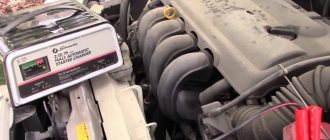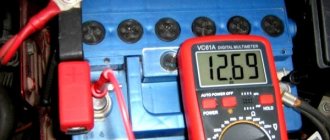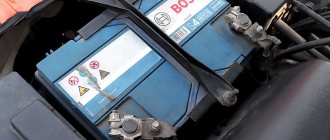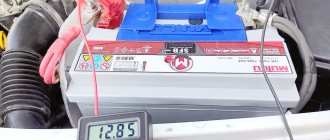- home
- car battery
- …
Winter is coming, and this means a number of drivers (especially beginners) will put their cars on hold. The winter period is generally difficult, and therefore many do not operate their cars, yet driving and operation are much different from the summer period. BUT if you don’t drive your car, it’s time to think about its important elements, say the battery. After all, if parked for a long time, it can become discharged and even fail! So how to store it correctly, should it be charged or can it also be stored in a discharged state? Let's get this issue right...
I’ll say this - guys, if you don’t plan to travel all winter, and in the middle zone this starts in late autumn, say from the end of October and lasts until the end of March. And this “just for a minute” is almost 6 months. If you do not remove the battery from the car and store it correctly, during this time it can become hopelessly discharged, followed by sulfation , and even shedding of the active mass, that is, “complete death.” Therefore, for that long period, it is better to remove the battery and store it in a warm and dry place.
Dry or wet
To begin with, I want to say a few words about new batteries, which are better, dry-charged or “wet” version? Of course, it’s not entirely on topic, but it’s worth mentioning; still, many people ask me - how are new batteries stored?
“Dry” - as a rule, these are old, serviceable batteries; they were stored dry in warehouses for quite a long time. That is, there was no electrolyte inside and the battery was in a dark, dry and warm room. Such batteries could be stored for quite a long time, the only disadvantages are the oxidation of the plates (although they are made of lead, they are metal), however, if certain conditions are maintained - low humidity and a temperature of about 15 degrees Celsius, then such options could be stored for several years.
“Wet” or “tucked” is a modern option. That is, the battery has already been filled with electrolyte, it is charged, and it is sealed on top - this is a maintenance-free option. It is much more difficult to store them; firstly, you need to monitor the density of the electrolyte so that it does not fall (fortunately, modern batteries have special “ green eyes ”). Secondly, you must always monitor the voltage level; you should not allow a discharge even to 12 Volts, this can provoke sulfation. Thirdly, the electrolyte, of course, cannot evaporate (due to the fact that the jars are sealed), but sulfuric acid due to prolonged inactivity, this is also not very good.
Of course, a maintenance-free option is ideal for the end user; there is no need to “steam”, pour distilled water into jars, and there is practically no need to monitor it; set it and forget it for 3 to 5 years. BUT before selling such batteries, you also need to track them and ideally, they should have been released a month or two or three ago. Otherwise, you can take last year’s one, which was not stored correctly, this can reduce its capacity, even if not used for its intended purpose.
Preparing the battery for storage
Of course, new batteries are good, but we have a used one in our car, how should we store it? To begin with, you simply need to prepare it. There are three very important steps:
- Cleaning the battery before storage. It is very important! REMEMBER! The surface of the batteries, as usual, is dirty, that is, there is oxidation on top, dust, dirt, moisture, remnants of coolant (TOSOL or Antifreeze), and sometimes even oil. All this can form microbridges between the terminals, especially if they are liquids. Microcurrents can discharge the battery slowly but surely, which will ultimately (if you are not careful) lead to a deep discharge .
- Checking the density and level of electrolyte. This applies to serviced batteries; the normal density should be 1.28 g/cm3. The level of electrochemical liquid in the jars must cover the plates! If you have a maintenance-free option, then you need to monitor the green eye indication.
- Charger. You definitely need to check the voltage, remember - it should be at least 12.4, and ideally 12.7 Volts. If it is 12V, or maybe less, say 11.7, then you urgently need to charge the battery before storage.
I also recommend that you cover the terminals of the removed battery with special technical petroleum jelly or analogues, this will reduce their oxidation with the surrounding air.
Accumulator charging
Keep your car battery CHARGED! This is necessary, since when the battery is completely discharged, its capacity will decrease by 10-20%, and the sulfation reaction will also start. How to determine that this process is running in the battery:
- Unscrew the plugs and look inside. If the plates are covered with a white coating, then sulfation flourishes there.
- When charging the battery, the electrolyte begins to boil quickly. Literally half an hour passes, and the battery shows maximum charge.
- After the battery is fully charged, it still does not start the car engine, and using a regular headlight reduces the battery to zero in 5-10 minutes.
- The battery capacity is significantly less than its original performance. For example, the usual capacity is 60 Am*h, and the battery produces 30 Am*h. It is obvious that the capacity has dropped catastrophically.
- If a white coating quickly forms on the battery, even though the surface is regularly wiped. This indicates constant boiling of the electrolyte. It is urgent to check the battery capacity.
We recommend: Normal current leakage from a car battery
Charged or discharged
In principle, I already wrote above - that the battery must be CHARGED before storage (and not only)! But there are a lot of rumors and “harmful” advice on the Internet about what can be stored in a discharged state! Guys THIS IS NOT CORRECT!
Let me note right away that a completely discharged battery is very, very bad! This will provoke sulfation of the plates, which will immediately reduce the capacity by 10 - 20%. If you charge immediately, then perhaps you can still perform desulfation (and this is not a fact), but if you store such a discharged battery for a long time, the sulfates will completely cover the plates and the active surface will be much reduced, it will be almost impossible to destroy them. That is, after long-term storage of a discharged battery, it may not be possible to recharge it, so I AGAIN EMPHASIZE IT SHOULD ONLY BE STORED IN A CHARGED CONDITION.
So where do they want legends about discharged storage? There were such options in the USSR, with serviceable batteries. They were charged, and then the electrolyte was gradually drained (the process lasted 15–20 minutes). Then the jars were washed with distilled water two to three times (another 20 minutes). Then boric acid is added to the jars and the battery is stored in this state, but the temperature must be at least 0 degrees Celsius. The voltage at the terminals is very low, that is, there is practically no voltage at all. That’s why the legend about the “discharged storage method” appeared, but that’s if you don’t understand it.
After such preservation, the boric acid is drained and a regular electrolyte (based on sulfuric acid) is added, we check the voltage, recharge if necessary, and 40 - 50 minutes after charging it can be used in a car.
I would also like to note that now such serviced options are becoming a thing of the past, because they require constant care, which is not acceptable for many owners.
How to preserve the battery during winter use of the car
The basic rule for saving the full battery life in the cold season is the uninterrupted operation of the vehicle’s on-board network. Before the onset of the winter season, you need to check:
- The serviceability of the wires going from the battery to the starter device and generator . Of course, even the slightest malfunctions in the rest of the electrical equipment cannot be neglected, since sometimes an insignificant power leak in winter is enough to completely discharge the power source.
- Battery terminals. In winter, you need to systematically free the terminals from dirt, then clean them with fine-grained sandpaper and lubricate them with lithol.
- Generator. It is recommended to check the voltage at the generator output: it should be within 14.5 V. Although the voltage according to the instructions is allowed up to 13.8 V, in winter, if it is less, the battery simply will not be fully charged while the car is moving.
- Timing belt. You also need to pay attention to the tension of the profile timing belt. If it slips, the battery may not be charged sufficiently.
- Electrolyte density. If the battery density is low (less than 1.27 g/cm³), you need to recharge it, and after some time after driving the car, check the density again. And if it turns out that the density is again below the specified parameters, it needs to be replaced before the winter season.
- Thermal insulation. Sometimes, especially in severe winters, preparing a battery involves insulating it, and only non-flammable material must be used.
- Gentle mode. Despite the normal density of the battery, in winter it is recommended to use lighter operation for the on-board electrical network. Even if the cabin is cool at first, you should not immediately turn on the stove, heated windows and other devices operating from a storage power source.
The better the battery is maintained at sub-zero temperatures, the longer it will last. You also need to remember when operating a car at this time of year that the battery does not “like” frequent engine starts, as well as trips over short distances. As a result, the service life is also significantly reduced.
Preparing the battery for winter
Before storing the battery, it must be prepared accordingly. Otherwise, when leaving in winter, it may “unexpectedly” discharge, forcing the driver to find unconventional ways to start the engine. To avoid such “surprises”, every car owner needs to know how and where best to store the battery in winter.
Storage conditions
There is a lot of advice and different opinions here, some people think that the battery should be stored in a cool, I would even say cold place, say in the basement. Someone, on the contrary, is warm and dry in an apartment near a heating radiator! Where is the truth?
The truth is as they say in the middle. A cold place from - 10 degrees to + 10 degrees is not entirely suitable, because such a temperature will discharge the stored battery faster.
A hot place is also not suitable. This is because temperatures of + 25 degrees and above provoke sulfation of the plates, which means a loss of capacity and, of course, a discharge. So you can’t store it near the battery!
A damp place provokes moisture on the surface, which can short-circuit the terminals with microcurrents, again causing a rapid discharge. So a barn won't do!
So where is the ideal place and what are its conditions? Everything is simple from + 10 to + 15 degrees Celsius, dry room. This could be a vestibule or storage room in your apartment, or a heated garage. It is worth noting that direct sunlight should also be avoided, especially for transparent batteries, because they also provoke degradation.
These are the most correct conditions; in general, you can store up to 20 degrees, but here the formation of sulfates on the plates is possible, although not in large volumes.
Should the battery be removed from the car in winter?
There is an opinion that car batteries need to be removed in winter to maintain their maximum charge. This statement is true, but not always; in some cases, you can get by with less radical solutions.
In “warm winter” conditions (when the air temperature where the car is stored does not drop below -10 degrees), in order to maintain maximum battery charge and not bother with moving the battery, it is recommended to reset one of the on-board network terminals from the power source. We recommend removing the negative terminal to avoid the risk of the positive contacting ground and short circuiting the on-board network. By removing one of the terminals from the car battery, it will be possible to greatly reduce the process of discharging the power source.
If the temperature in the place where the car is parked has dropped significantly below -10 degrees Celsius, you should think about moving the battery to a warmer room. At the same time, do not forget that if the battery is completely disconnected from the vehicle’s on-board network, the settings of the electronic systems will be reset.
How long can a battery be stored without recharging?
This is generally a topic for a separate article, but I would like to briefly touch upon it in this one, for the general concept. If we now divide batteries, they are divided into three main types:
- Low antimony - this is the most common lead-acid battery; the amount of antimony in it is reduced to 3%. But there is a lot of water consumption. Such options can be stored for up to 3 months, then be sure to check the charge.
- Hybrid - it contains both antimony (from 1.4 to 1.8%) and cadmium (1.6 - 1.8%), there may be other impurities. They require half as much water. Storage without recharging for up to 5 months.
- Calcium – lead – calcium alloy, up to 0.2% Calcium. Such batteries can be stored for 8 to 12 months.
The more technologically advanced the battery, the longer it can last without recharging! However, personally, I would monitor the tension every month or two.
Now let's watch a short video.
I think my article was useful to you, read our AUTOBLOG.
Similar news
- How to light a battery from another car. Is it possible to do this...
- Which company (brand) to choose a battery for a car. My rate...
- Lubricating battery terminals. Why does a car need this?











